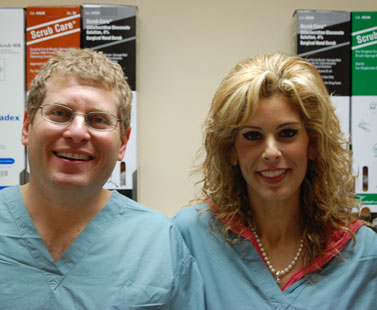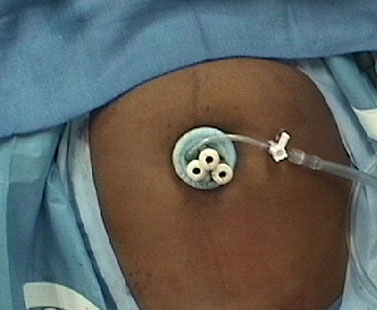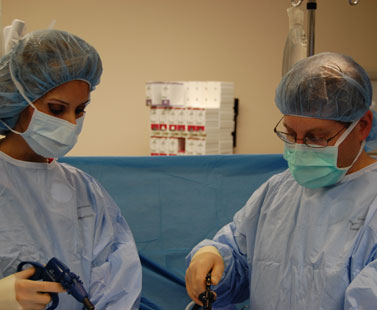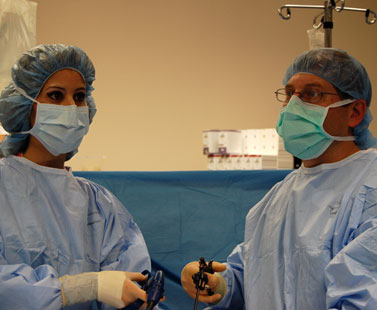More with LESS
USF surgeons report first laparoendoscopic single-site operation combining hysterectomy, gall bladder removal

Dr. Stuart Hart and Dr. Sharona Ross are among the USF physicians working to advance minimally invasive surgery to the next level.
USF Health surgeons recently removed the uterus and gall bladder of a 37-year-old woman, performing the combined operation through a single entry point – the patient’s belly button. The advanced minimally invasive procedure, known as Laparoendoscopic Single-Site Surgery or LESS, left virtually no scar and the patient went home the next day.
“To the best of our knowledge, this appears to be the first combined single incision procedure involving both a hysterectomy and cholecystectomy (gall bladder removal),” said Stuart Hart, MD, assistant professor in the USF Division of Urogynecology and Reconstructive Pelvic Surgery, Department of Obstetrics and Gynecology.
The USF surgeons have also successfully performed the first single-incision laparoendoscopic procedure to remove an adrenal gland tumor. They have used single incision laparoendoscopic techniques at Tampa General Hospital to remove the appendix and liver cysts, to repair hernias, and to treat acid reflux disease and achalasia (a disorder of the esophagus).
For the patient, LESS has the cosmetic advantage of virtually no scar since it requires only one tiny laparoscopic incision, typically in the navel, instead of several incisions spaced throughout the abdomen. Physicians say fewer incisions mean quicker recovery time, less pain and less risk for bleeding and infections.
The combined operation was performed in February at TGH. Alexander Rosemurgy, M.D; Sharona Ross, MD; and Kellie McFarlin, MD, all from the USF Health Division of General Surgery; initially removed the patient’s gall bladder. The uterus was then removed by Dr. Hart with the assistance of the General Surgery team. The entire case took approximately three hours.

Multiple instruments were passed through a specially-designed port inserted through the patient’s belly button.
The surgeons operated by inserting a specially-designed laparoscopic port and laparoscopic camera to perform the surgical procedure. Since typically several ports are required to pass the laparoscopic instruments into the abdomen to perform the surgery, state-of-the-art instruments were required to make this surgical procedure possible. A specially designed port was placed through the belly button which allowed the surgeons to pass multiple instruments through one incision. The laparoscope, which has a miniaturized digital camera embedded in the tip, transmits high-resolution pictures of internal organs onto a video monitor. Once positioned inside the abdominal cavity, the camera can move in many directions, helping surgeons avoid unnecessary trauma to tissue and nearby vessels.
“With LESS, we can still do a lot of surgery while significantly minimizing the insult of surgery inside and outside the body,” said Dr. Rosemurgy, professor of surgery, associate dean of Simulation and Academic Enrichment at the USF College of Medicine, and surgical director of the Center for Digestive Disorders at TGH.
“Advances in surgical technology, including miniaturization of devices, has helped make all this feasible,” said Dr. Ross, assistant professor of surgery and director of Surgical Endoscopy.
Surgical skills must also adapt and advance to make minimally-invasive techniques even less invasive. “Performing LESS surgery requires advanced laparoscopic skills and represents the new frontier of minimally invasive surgery,” Dr. Ross said. “Laparoscopic surgeons must be trained to operate through a single incision with the scope and instruments working in parallel.”

USF Health physicians from General Surgery and OB/GYN worked together to perform the combined minimally-invasive procedure.

More than 150 surgeons from across the country have come to Tampa General to learn LESS from Dr. Rosemurgy, Dr. Ross and Dr. Michael Albrink. They are developing single-incision surgeries using natural orifices (vagina, anus, mouth) and working with industry leaders to help refine the equipment and tools needed to take minimally invasive surgeries to the next level.
Dr. Hart and Dr. Larry Glazerman, co-directors of USF Center for the Advancement of Minimally Invasive Pelvic Surgery, helped launch the inaugural Advanced Laparoscopic Gynecologic Surgery Conference at the new USF Health Simulation Center at Tampa General the weekend of March 28-30.

